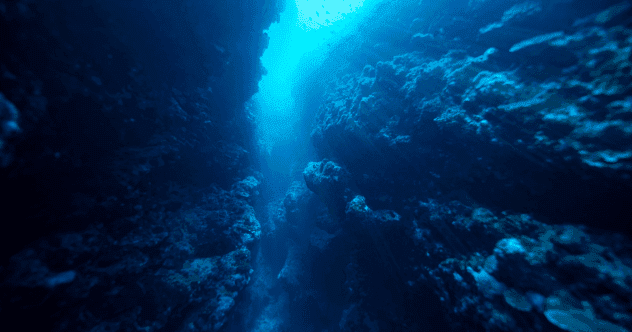From the beginning, the ocean has shaped our planet’s ecosystems, weather patterns, and even human history. It provides resources, gateways for exploration, and endless inspiration. Yet, most of its depths remain uncharted. According to the National Ocean Service, less than 10% has been mapped. Even the small amount we’ve seen leaves us in awe. Here are ten incredible facts about the ocean.
10. The Ever-Growing Atlantic Ocean
The ocean floor has a massive crack where the Earth’s crust is constantly created. Magma rises, cools, and pushes aside older crust. This is the Mid-Atlantic Ridge, where the Eurasian and North American Plates are splitting in the Northern Hemisphere.
South of the equator, the African and South American Plates are also separating, widening the ridge by up to 2 inches (5 cm) a year. The Mid-Atlantic Ridge spans nearly 10,000 miles (16,093 km) and is part of a larger global mid-ocean ridge system.
This system stretches 40,390 miles (65,001 km), making it the planet’s largest geological feature, almost twice the length of Earth’s equator. Scientists have found hydrothermal fields with underwater hot springs, adding to the geological activity.
You can experience parts of the Mid-Atlantic Ridge on volcanic islands like Ascension Island, St. Helena, and Iceland.
9. Plunging into Challenger Deep
Challenger Deep, at the bottom of the Mariana Trench, is the deepest known point on Earth, reaching over 35,760 feet (10,900 meters). It’s an extreme abyss that few have visited.
The first manned expedition was in 1960 when Don Walsh and Jacques Piccard spent about 30 minutes there. In 2012, James Cameron dove solo, spending a few hours and returning with a silt sample.
Since 2019, more expeditions have occurred, including those by astronaut Kathryn D. Sullivan and mountaineer Vanessa O’Brien, the first woman to reach this depth. Victor Vescovo holds the record with fifteen descents.
Explorations have revealed constant noise from earthquakes, whales, and ships. The depths are home to bizarre animals like the dragonfish.
8. The Ocean’s Terrifying Depths
Almost 10% of people have thalassophobia, the fear of the ocean. Is it scarier than space? Experts say yes!
Columbia University Astrophysicist Summer Ash noted, “In space, only physics wants to kill you, but in the ocean, it’s physics PLUS biology!”
The pressure at the deepest part of the ocean exceeds 16,000 PSI, over 1,000 times the pressure at sea level. Besides the pressure, you can’t drink the water, hypothermia is a risk, and many animals pose danger. The ocean can be deadly quickly or slowly, offering a false sense of hope.
7. Secret Underwater Rivers
Imagine finding a real river flowing on the seafloor while scuba diving. Anatoley and his friends discovered “Cenote Angelita” near Tulum, Mexico, complete with trees and leaves drifting along the ocean floor.
Underwater rivers have also been found in the Black Sea and off the coasts of Australia and Portugal.
Dr. Dan Parson from the University of Leeds discovered a river at the bottom of the Black Sea, while robots found one near Australia. These discoveries have scientists excited about harnessing the power of these rivers.
6. The Ocean’s “Twilight Zone”
Between 650 and 3,500 feet (198 and 1,067 m) lies the ocean’s twilight zone—a dark, cold realm untouched by sunlight.
The Ocean Twilight Zone Project studies the secrets of this zone, where many creatures create their own light to attract food or for defense. Some use counterillumination to avoid being seen.
Scientists believe the twilight zone may contain more fish biomass than the rest of the ocean combined. Understanding it sheds light on water, nutrient, and carbon cycles critical to the global climate process.
5. The Ocean: Earth’s Thermostat
The ocean maintains Earth’s temperature by absorbing and dissipating the sun’s energy, especially in tropical waters. Land and atmosphere retain warmth.
The ocean shares warmth worldwide, with almost all rainfall starting as oceanic vapor. Tropical regions receive abundant rain as the ocean heats and evaporates.
Ocean currents, driven by winds, temperature differences, Earth’s rotation, and the moon’s gravity, transport warm water and precipitation from the equator to the poles, and cold water back to the tropics.
Without these currents, the world would experience extreme temperature differences, making much of Earth uninhabitable.
4. A Sea of Riches
An estimated 20 million tons of gold lie within the ocean’s depths. However, it exists in minuscule concentrations, about 13 billionths of a gram per liter of seawater.
Extracting this gold is not cost-effective. Until a better method emerges, these golden dreams remain just that—Hollywood stories.
3. The Mystery of “The Bloop”
In 1997, researchers monitoring the ocean for volcanic activity detected an extremely loud and perplexing sound, dubbed “The Bloop.”
The Bloop sparked theories ranging from underwater military exercises to giant marine creatures.
After eight years, more hydrophones tracked the sound to its source: an icequake.
2. The Coriolis Effect
Objects moving across Earth’s surface, like air or water, appear to curve due to different parts of the planet spinning at different speeds.
In the Northern Hemisphere, objects curve to the right; in the Southern Hemisphere, they curve to the left. This is the Coriolis effect.
The Coriolis effect influences global wind patterns, ocean currents, and airplane flight paths.
1. The Ocean’s Trash Problem
The Great Pacific Garbage Patch (GPGP), between Hawaii and California, is the largest of the five plastic accumulation zones in our oceans. Each year, up to 2.66 million tons (2.41 million metric tons) of plastic end up in the sea.
The patch covers 0.62 million square miles (1.6 million square kilometers), larger than Texas and France combined.
Many companies are working on cleanup efforts. Recently, scientists in Australia discovered a mold that can break down plastic in 140 days, offering hope for the future.
The ocean holds countless mysteries and plays a crucial role in our planet’s health. From its deepest trenches to its floating garbage patches, understanding the ocean is essential. Let’s continue to explore and protect this vital resource.
What fact surprised you the most? Leave your thoughts in the comments below!










